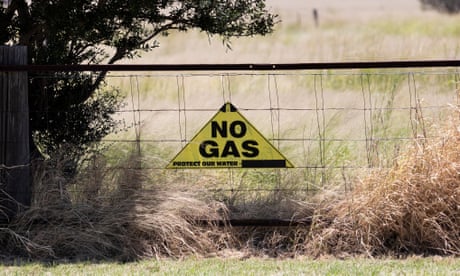- by foxnews
- 04 Apr 2025
Queensland government faulted for slow response to gas seep and calling Knitting Nannas a ‘risk’
Queensland government faulted for slow response to gas seep and calling Knitting Nannas a ‘risk’
- by theguardian
- 09 Feb 2022
- in news

The Queensland government's response to a gas seep "capable of posing risk to life or property" near Chinchilla included a briefing memo about the incident that described a local Knitting Nannas Against Gas group as a "risk".
On 24 July 2020, a landowner about 10km from Chinchilla discovered water and gas bubbling from several former coal exploration bores on the property. The seep occurred near a section of the Condamine River where methane had previously bubbled to the surface.
Documents released under Queensland Right to Information laws detail how the bores were releasing water and gas in an "uncontrolled manner that would appear to be capable of posing a risk to life or property" and required "urgent remediation" work, according to the state Department of Natural Resources, Mines and Energy.
Conservation group Lock the Gate claims the documents show the government did not act with necessary urgency - it took six days for the state department to consult with resource companies and authorise access to the site for remediation.
One briefing note written by departmental staff on 30 July 2020 - the same day the remediation was authorised - lists "risks" associated with the incident.
"The risk of media attention is considered low due to the borehole location being away from public view," the memo says.
"However, it is noted that anti coal-seam gas (CSG) sentiment exists around Chinchilla, with an active 'Knitting Nannas Against Gas' group, and several anti-CSG advocates and landholders in the area.
"There is a low/moderate risk that the brackish water discharge could negatively impact the landholder's cropping land and/or dam water.
"This risk is mitigated by the swift and active management of the incident."
Leanne Brummell, a member of the Knitting Nannas Against Gas group from St George, said it was troubling the government "was worried about a threat from the Nannas while a potential contamination emergency was unfolding".
In the previous few years, gas seeps in the vicinity of the same Chinchilla property had created concern among opponents of the CSG industry. In 2016, the NSW Greens MP Jeremy Buckingham set methane bubbles on the Condamine River on fire.
A report commissioned by the Queensland Department of Environment and Science last year found that Condamine bubbles are "a natural system" but that "the gas escape is enhanced by down-dip CSG production, which is approximately 1km away".
The exploration boreholes discovered bubbling in 2020 were drilled in 2007 by coalminer Yancoal at a site about 10km south-west of Chinchilla.
The property has overlapping coal and petroleum leases, and ultimately the operator of the petroleum lease - Origin - plugged the seeps with concrete.
Origin required government authorisation to enter the property and complete the remediation, and emails detail how this process took six days as public servants sought the input of both resource companies. Both Yancoal and Origin were supportive of the remediation work.
"It's hopeless that it took six days before there was a response, because the government processes are so poor that it needs permission from the coal company that left the bores un-rehabilitated before it can trigger action to address the incident.
"The CSG industry has dewatered vast areas of the Western Downs, and more than 100 water bores have already run dry, and now we're seeing incidents like this."
In a statement, the Queensland Department of Resources said the state's resources framework promotes coexistence of agriculture and resources, as well as managing environmental impacts.
"When historical and current resources activity overlap, management can be complex and involve a number of government entities, as well as landholders and resources companies," the statement said.
"In this case, the several entities involved attended the site promptly once the seep was reported, assessed the seep as low to medium risk, the site was made secure immediately, and later fully remediated once the responsible resources company was established."
- by foxnews
- descember 09, 2016
'I traveled for an entire year for free - and saved $15K'
Hailey Learmonth explored Australia without paying rent, thanks to pet sitting. She saved $15,000, lived on farms, and embraced remote work to travel on a budget.
read more


